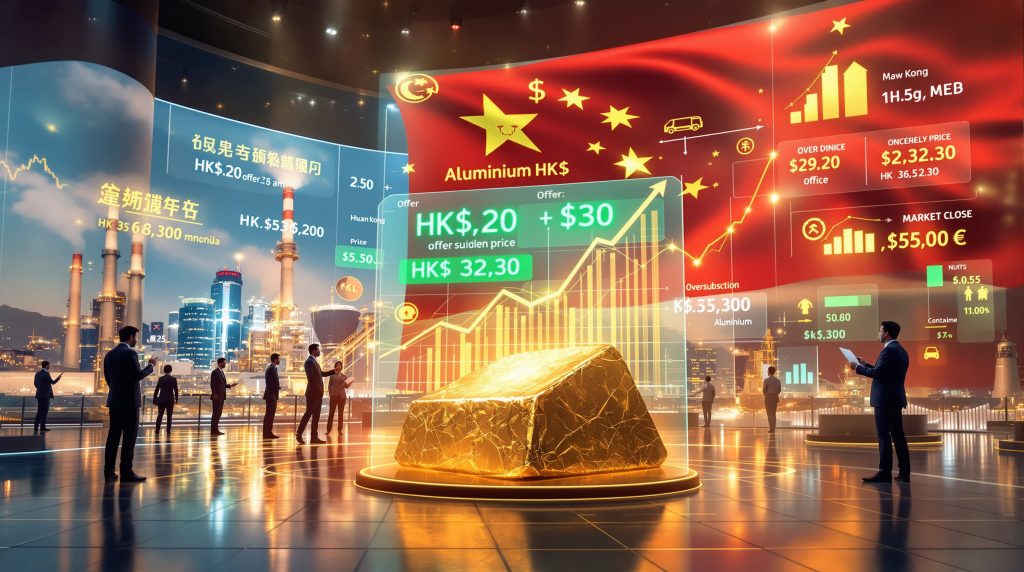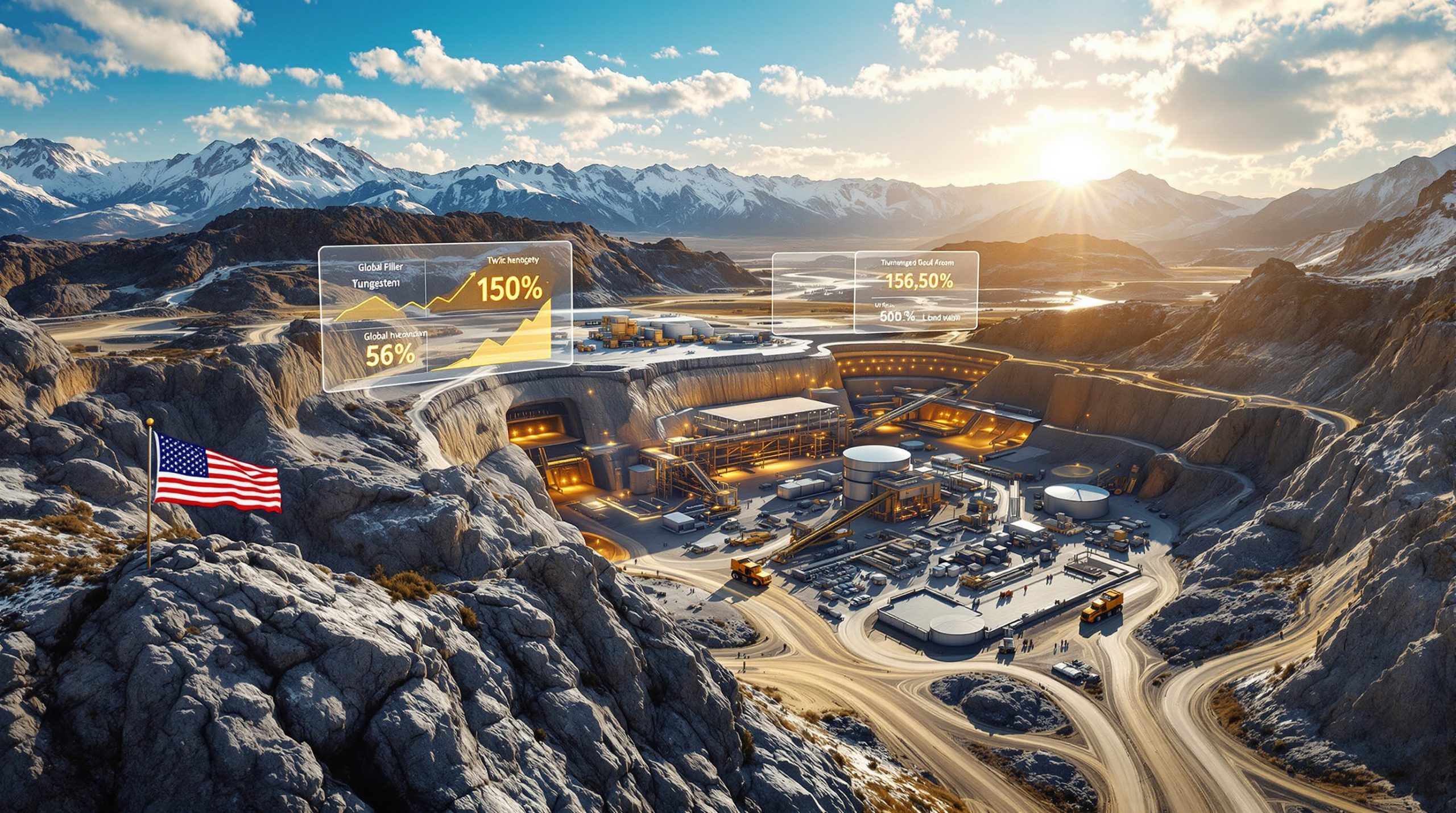What Drives Major Equity Raises in China's Industrial Metals Sector?
Institutional investor psychology often follows predictable patterns when analyzing capital allocation opportunities in cyclical industries. The decision-making process behind major equity raises reveals complex interactions between market timing, sector momentum, and corporate strategic positioning that extend far beyond simple funding requirements.
Market Psychology Behind Large-Scale Share Placements
Understanding why investors participate in substantial equity placements requires examining the behavioral dynamics that drive institutional decision-making. When commodity prices reach multi-year highs, institutional investors face a psychological tension between fear of missing out on continued gains and concern about buying at peak valuations.
The recent China Hongqiao aluminium share sale demonstrates how companies leverage favorable market sentiment to execute large-scale fundraising initiatives. With shares gaining 153.4% year-to-date through November 2025, the timing reflects sophisticated understanding of investor appetite during commodity bull cycles.
Furthermore, the mining industry evolution demonstrates how technological advances and market dynamics create optimal windows for capital deployment. Moreover, current China iron ore trends indicate broader commodity sector momentum that supports strategic fundraising initiatives.
Timing Strategic Capital Raises During Commodity Cycles
Corporate treasury departments in metals companies typically maintain detailed models tracking the correlation between commodity prices and equity market receptiveness. The decision to proceed with a HK$11.68 billion (US$1.5 billion) share placement while aluminium trades near three-year highs represents calculated risk management.
Historical analysis suggests that metals producers who successfully time equity raises during price peaks create significant competitive advantages. These companies secure growth capital when borrowing costs remain elevated relative to equity financing, while simultaneously strengthening balance sheets ahead of potential commodity price corrections.
Investor Appetite for Chinese Industrial Giants
International institutional investors demonstrate recurring patterns when evaluating Chinese industrial companies during commodity upcycles. The combination of China's dominant global metals production capacity and improving corporate governance standards creates compelling investment narratives for portfolio managers seeking emerging market exposure.
Private aluminium producers in China benefit from unique positioning advantages relative to state-owned enterprises, offering investors direct exposure to market-driven operational efficiency improvements and capital allocation decisions. Additionally, record-high gold prices illustrate how commodity sector strength supports broader investment appetite.
How Do Aluminium Market Dynamics Influence Corporate Financing Decisions?
Three-Year Price Highs and Capital Allocation Strategies
Current aluminium market conditions reflect fundamental supply-demand imbalances that create strategic windows for corporate financing activities. Trading near three-year highs driven by solid demand and measured supply, the metal's price trajectory influences how producers prioritize capital allocation between debt reduction and growth investments.
Companies operating in this environment face optimal conditions for equity fundraising, as institutional investors recognize the sustainability of current margin profiles. The timing of major capital raises during peak pricing periods allows producers to lock in funding at attractive valuations while maintaining operational flexibility.
Supply Chain Constraints Creating Investment Opportunities
Global aluminium supply chains continue experiencing structural constraints that support elevated pricing environments. These conditions create compelling investment cases for producers with integrated operations and expansion capabilities, as market participants recognize the strategic value of additional production capacity during supply-constrained periods.
The measured supply response to current pricing levels indicates industry discipline that supports sustained margin expansion for existing producers. This dynamic encourages institutional investors to participate in equity raises that fund capacity additions or operational improvements.
Demand Surge from AI Infrastructure and Electric Vehicles
Emerging demand drivers for aluminium extend beyond traditional construction and packaging applications into high-growth technology sectors. Artificial intelligence infrastructure requirements and electric vehicle production create new demand categories with different price elasticity characteristics compared to conventional end uses.
These structural demand shifts support investor confidence in long-term aluminium consumption growth, providing fundamental backing for current price levels and creating favorable conditions for producer equity fundraising activities.
What Makes a $1.5 Billion Share Sale Attractive to Institutional Investors?
Discount Pricing Strategy Analysis
| Pricing Element | Value | Market Signal |
|---|---|---|
| Offer Price | HK$29.20 | Strategic positioning below market |
| Market Close Price | HK$32.30 | Reference point for discount calculation |
| 30-Day Average | HK$28.58 | Indicates premium to recent trading |
| Discount to Market | 9.6% | Attractive entry point for institutions |
| Premium to 30-Day Average | 2.2% | Reflects recent share price strength |
The pricing structure reflects sophisticated understanding of institutional investor requirements during large-block equity transactions. The 9.6% discount to closing prices provides immediate value creation opportunities while the 2.2% premium to the 30-day average demonstrates respect for recent trading patterns.
This dual-reference pricing approach addresses different institutional investor mandates, accommodating both value-focused strategies seeking immediate discounts and growth-oriented approaches willing to pay premiums for exposure to sector leaders during favorable market cycles.
Oversubscription Signals and Market Confidence Indicators
Large-scale share placements in the Asian metals sector typically generate significant institutional interest when structured during optimal market conditions. The combination of sector-leading market position, favorable commodity pricing, and attractive discount structures creates compelling value propositions for portfolio managers.
Post-announcement trading dynamics provide immediate feedback on market reception, with the 7.7% decline to HK$29.80 representing typical institutional arbitrage activity as investors position for the placement pricing while existing shareholders adjust positions. According to recent market analysis, the share placement demonstrates strong institutional confidence in the sector.
Capital Deployment Priorities for Growth-Stage Metals Producers
The stated use of proceeds for projects and debt repayment reflects balanced capital allocation strategies that address both growth opportunities and financial optimization. This approach appeals to institutional investors seeking exposure to companies that demonstrate disciplined financial management during commodity cycles.
Debt reduction components of the capital raise enhance financial flexibility and reduce leverage ratios, improving the company's ability to pursue opportunistic investments or weather potential commodity price volatility. Project funding components signal confidence in current market conditions and commitment to maintaining competitive positioning.
Why Are Private Aluminium Producers Expanding During Market Peaks?
Integrated Operations Advantage in Volatile Markets
Private aluminium producers with integrated operations maintain significant competitive advantages during volatile commodity cycles compared to non-integrated competitors. Vertical integration across bauxite mining, alumina refining, and aluminium smelting provides natural hedges against input cost fluctuations while maximising margin capture during favourable pricing periods.
The strategic decision to raise equity capital during peak markets reflects understanding that integrated producers can generate superior returns on invested capital when commodity prices support healthy margins across the entire production chain. This operational model creates sustainable competitive moats that institutional investors value highly.
Infrastructure Investment Timing in Cyclical Industries
Capital-intensive industries like aluminium production require careful timing of infrastructure investments relative to commodity cycles. Companies that successfully execute major capital projects during favourable market conditions position themselves for enhanced market share and profitability during subsequent cycles.
The current fundraising initiative, following a previous US$300 million convertible bond raise in March 2025, demonstrates systematic approach to financing growth investments when market conditions optimise both funding costs and future return potential.
Debt Reduction Strategies for Capital-Intensive Operations
Aluminium production requires substantial ongoing capital investments in equipment maintenance, environmental compliance, and efficiency improvements. Managing debt levels during commodity peaks creates financial flexibility for future expansion opportunities while reducing interest expense burdens during potential price corrections.
Strategic debt reduction during favourable market cycles represents prudent risk management that appeals to institutional investors focused on downside protection. Companies with stronger balance sheets maintain better access to capital markets during challenging periods and can pursue counter-cyclical growth opportunities.
How Do Hong Kong Equity Markets Support Chinese Industrial Expansion?
Cross-Border Capital Flow Dynamics
Hong Kong's equity markets provide unique access points for international institutional investors seeking exposure to Chinese industrial companies without navigating mainland regulatory complexities. This positioning creates liquidity advantages and valuation premiums for Hong Kong-listed Chinese companies relative to mainland exchanges.
The regulatory framework supporting cross-border capital flows enables Chinese companies to access global institutional capital while maintaining operational flexibility. International investors benefit from familiar trading infrastructure and regulatory oversight that reduces perceived risks associated with Chinese industrial investments.
International Investor Access to Chinese Metals Exposure
Portfolio managers seeking diversified exposure to Chinese metals production find Hong Kong listings provide optimal combination of liquidity, regulatory transparency, and currency flexibility. The 400 million share placement represents approximately 4% of enlarged share capital, providing substantial opportunity for institutional participation without overwhelming market liquidity.
This market structure enables efficient price discovery and supports sustained institutional interest in Chinese industrial companies, particularly during favourable commodity cycles when international demand for metals exposure increases significantly.
Regulatory Environment for Large-Scale Fundraising
Hong Kong's established regulatory framework for equity capital markets facilitates complex fundraising transactions through streamlined approval processes and standardised disclosure requirements. These structural advantages enable Chinese companies to execute large-scale equity raises more efficiently than alternative venues.
The combination of international investor access, established market infrastructure, and regulatory predictability creates optimal conditions for substantial fundraising initiatives by Chinese industrial companies during favourable market windows.
What Investment Risks Should Investors Consider in Chinese Aluminium Stocks?
Commodity Price Volatility Impact on Share Performance
Aluminium price movements create direct earnings volatility for producers, with share prices typically exhibiting higher volatility than underlying commodity prices. The 153.4% year-to-date gain followed by 7.7% single-day decline demonstrates the amplified equity market response to commodity sector developments.
Investors must evaluate their risk tolerance for commodity-linked equity exposure, particularly when valuations reflect current peak pricing conditions. Historical analysis suggests metals stocks experience significant corrections during commodity price declines, requiring careful position sizing and risk management strategies.
However, considering broader market factors such as US-China trade war effects and how tariffs impact markets, investors must also assess geopolitical risks that could affect Chinese industrial companies beyond commodity price movements.
Environmental Regulation Changes in China's Industrial Sector
China's evolving environmental regulatory framework creates ongoing compliance costs and operational constraints for aluminium producers. Changes in emissions standards, energy consumption limits, or waste disposal requirements can significantly impact production costs and facility utilisation rates.
Companies with older production facilities or suboptimal environmental compliance infrastructure face higher regulatory risks that could affect long-term profitability and market positioning. Investors should assess environmental compliance track records and planned investments in sustainable production technologies.
Global Trade Dynamics Affecting Chinese Metal Exports
International trade policies and tariff structures significantly influence Chinese metals producers' access to global markets and pricing power. Changes in trade relationships or export restrictions could affect revenue streams and growth opportunities for companies with significant export exposure.
Currency exchange rate fluctuations between the Chinese yuan, Hong Kong dollar, and major trading partner currencies create additional volatility factors that impact financial performance and complicate earnings forecasting for international investors.
How Does This Capital Raise Compare to Other Major Industrial Fundraising Events?
Asian Metals Sector Fundraising Trends in 2025
The HK$11.68 billion fundraising represents one of the largest equity capital raises in the Asian metals sector during 2025, reflecting both company-specific growth opportunities and favourable market conditions for commodity-linked equity transactions.
Comparing this initiative to the previous US$300 million convertible bond raise demonstrates escalating capital requirements and increasing investor appetite for exposure to leading Chinese aluminium producers during favourable market cycles.
Scale and Timing Comparison with Industry Peers
Large-scale equity fundraising in the metals sector typically occurs during optimal windows when commodity prices, equity market conditions, and corporate growth opportunities align favourably. The timing and size of this placement reflects sophisticated market timing relative to commodity cycles and equity market receptiveness.
The discount structure and institutional participation patterns provide benchmarks for evaluating future equity capital transactions by Chinese industrial companies seeking to access international institutional capital during commodity upcycles. Industry reports from Mining.com highlight the strategic importance of this fundraising initiative.
Strategic Positioning for Next Market Cycle
Companies that successfully raise substantial equity capital during commodity peaks position themselves advantageously for subsequent market cycles through reduced leverage, enhanced growth capabilities, and improved competitive positioning relative to peers with constrained capital access.
This strategic approach to capital raising during favourable markets creates sustainable competitive advantages that extend beyond immediate funding requirements, supporting long-term market share expansion and profitability optimisation.
What Are the Long-Term Implications for China's Aluminium Industry Leadership?
Capacity Expansion Plans and Market Share Consolidation
China's position as the world's dominant aluminium producer continues strengthening through strategic capacity additions by leading private producers. Companies with access to substantial capital during favourable market conditions can pursue expansion initiatives that consolidate market leadership positions.
The funding allocated toward projects signals commitment to maintaining technological leadership and production efficiency advantages that support China's global competitiveness in aluminium markets. These investments create barriers to entry for potential competitors while enhancing long-term profitability.
Technology Investment Priorities for Competitive Advantage
Modern aluminium production requires continuous investment in energy efficiency, environmental compliance, and process optimisation technologies. Companies with strong capital positions can accelerate technology adoption that creates sustainable cost advantages and regulatory compliance capabilities.
Investment in advanced production technologies during favourable market cycles creates long-term competitive moats that support market leadership positions during subsequent commodity cycles, particularly as environmental regulations become more stringent globally.
Global Supply Chain Integration Strategies
Chinese aluminium producers with substantial capital resources can pursue vertical integration and global supply chain optimisation strategies that enhance operational efficiency and market position. These investments create diversified revenue streams and reduced exposure to individual market or geographic risks.
Strategic capital deployment toward supply chain integration during peak markets positions companies for sustained competitive advantages while reducing dependence on external suppliers and market intermediaries.
Key Takeaways for Investors Monitoring Chinese Industrial Metals
Market Timing Lessons from Major Share Sales
The successful execution of large-scale equity raises during commodity peaks demonstrates the importance of market timing in optimising capital access and valuation outcomes. Companies that maintain financial flexibility to capitalise on favourable windows create significant advantages over competitors with constrained timing options.
Institutional investors benefit from understanding these timing dynamics when evaluating participation in major equity transactions, as market conditions significantly influence both immediate pricing and long-term return potential.
Due Diligence Factors for Commodity-Linked Investments
Effective analysis of metals sector investments requires comprehensive evaluation of operational efficiency, environmental compliance, market positioning, and capital allocation strategies. The combination of commodity price sensitivity and regulatory complexity demands thorough due diligence processes.
Key evaluation criteria include:
- Integrated operations advantages and cost structure sustainability
- Environmental compliance track record and planned investments
- Market position strength relative to domestic and international competitors
- Capital allocation discipline during various commodity cycle phases
- Balance sheet flexibility for opportunistic investments and downside protection
Portfolio Allocation Considerations for Metals Exposure
Chinese industrial metals stocks provide unique exposure to global commodity cycles, emerging market growth dynamics, and technological transformation in traditional industries. Portfolio managers must balance these opportunities against inherent volatility and regulatory risks.
Successful metals sector allocation requires understanding of commodity cycle timing, currency exposure management, and appropriate position sizing relative to overall portfolio risk tolerance. The sector's cyclical nature demands active management approaches rather than passive buy-and-hold strategies.
Disclaimer: This analysis is for informational purposes only and does not constitute investment advice. Commodity-linked investments involve significant risks including price volatility, regulatory changes, and geopolitical factors. Past performance does not guarantee future results. Investors should conduct their own due diligence and consult with qualified financial advisors before making investment decisions.
Looking for the Next Big Mining Discovery?
Discovery Alert's proprietary Discovery IQ model delivers real-time alerts on significant ASX mineral discoveries, instantly empowering subscribers to identify actionable opportunities ahead of the broader market. Understand why historic discoveries can generate substantial returns by visiting Discovery Alert's dedicated discoveries page, showcasing examples of exceptional market outcomes from major mineral finds.




